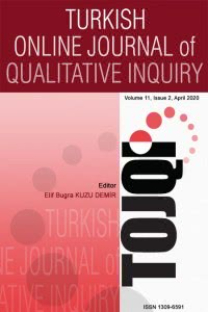Pre-Service Language Teachers' Reflections on the Implementation of a Blended-Learning Environment
Yabancı Dil Öğretmen Adaylarının Harmanlanmış Öğrenme Uygulaması Hakkındaki Görüşleri
___
- Allwright, D., & Hanks, J. (2009). The developing language learner: An introduction to exploratory practice. Basingstoke: Palgrave Macmillan. Caner, M. (2010). A blended learning model for teaching practice course.Turkish Online Journal of Distance Education (TOJDE), 11(3), 78-97.
- Creswell, J. W. (2007). Qualitative inquiry & research design: Choosing among five approaches (2nd ed.). Thousand Oaks, London, New Delhi: Sage Publications. Denzin, N. K., & Lincoln, Y. S. (2005). Introduction: The discipline and practice of qualitative research. In N. K. Denzin & Y. S. Lincoln (Eds.), The SAGE handbook of qualitative research (pp. 1-32). Thousand Oaks, London, New Delhi: SAGE. Dooly, M., & ODowd, R. (2012).Researching online foreign language interaction and exchange: Theories, methods and challenges. Berlin: Peter Lang. Farrell, C.S.T. (2007). Reflective language teaching : From research to practice. New York: Continuum. Freese, A. R. (2006). Reframing ones teaching: Discovering our teacher selves through reflection and inquiry. Teaching and Teacher Education, 22(1), 100-119.
- Goldman, Z. (2011). Balancing quality and workload in a synchronous online discussions: A win-win approach for students and instructors. MERLOT Journal of Online Learning and Teaching, 7(2), 313-323.
- Hampel, R., & Hauck, M. (2006). Computer-mediated language learning: Making meaning in multimodal virtual learning spaces. JALT CALL Journal, 2(2), 318.
- Hauck, M., & Warnecke, S. (2012). Materials design in CALL: social presence in online environments. In T. Michael; H. Reinders, & M. Warschauer (Eds.), Contemporary computer-assisted language learning (pp. 95115). London: Bloomsbury. Hockly, N. (2012). Digital Literacies. ELT Journal, 66(1), 108-112.
- Hoven, D. (2006). Designing for disruption: Remodelling a blended course in technology in (language) teacher education. In L. Markauskaite, P. Goodyear & P. Reimann (Eds.), Proceedings of the 23rd Annual Ascilite Conference: Whos Learning? Whose Technology? (pp. 339-349).
- Sydney: University of Sydney. Kehrwald, B. (2008). Understanding social presence in text-based online learning environments. Distance Education, 29(1), 89.
- Kehrwald, B. (2010). Being online: Social presence and subjectivity in online learning. London Review of Education, 8(1), 3950.
- Kolb, D.A. (1984). Experiential learning : Experience as the source of learning and development. Englewood Cliffs, NJ: Prentice Hall. Loughran, J. J. (2002). Effective reflective practice: In search of meaning in learning about teaching. Journal of Teacher Education, 53(1), 33-43.
- Peachy, N. (2013).A blended learning teaching development course for the development of blended learning in English language teaching. In B. Tomlinson & C. Whittaker (Eds.), Blended learning in English language teaching : Course design and implementation (pp. 65-73). London: British Council. Pegrum, M. (2009). From blogs to bombs: The future of digital technologies in education. Perth: University of Western Australia Press. Pica, T., Kanagy, R., & Falodun, J. (1993). Choosing and using communication tasks for second language instruction and research. In G. Crookes & S. Gass (Eds.), Tasks and language learning : Integrating theory and practice (pp. 934). Clevedon, England: Multilingual Matters. Richards, K. (2003). Qualitative inquiry in TESOL. Palgrave Macmillan. Richardson, W. (2006). Blogs, wikis, podcasts, and other powerful web tools for classrooms. Thousand Oaks, CA: Corwin Press. Stake, R. E. (1995). The art of case study research. Thousand Oaks, London, New Delhi: SAGE. Stake, R. E. (2005). Qualitative case studies. In N. K. Denzin & Y. S. Lincoln (Eds.), The SAGE handbook of qualitative research (pp. 1-32).
- Thousand Oaks, London, New Delhi: SAGE. Stainton-Rogers, W. (2006). Logics of inquiry. In S. Potter (Ed.), Doing postgraduate research (pp. 73- 91).
- London, Thousand Oaks, New Delhi: SAGE. Strauss, A. L., & Corbin, J. M. (1998). Basics of qualitative research: techniques and procedures for developing grounded theory (2nd ed.). London, Thousand Oaks, New Delhi: SAGE. Sutton, L. A. (2001). The principle of vicarious interaction in computer-mediated communications. International Journal of Educational Telecommunications, 7(3), 223242.
- Vonderwell, S., & Sachariah, S. (2005). Factors that influence participation in online learning. Journal of Research on Technology in Education, 38(2), 213-230.
- Williams, B. (2004). Participation in on-line courses - how essential is it? Educational Technology & Society, 7(2), 18. Yin, R. K. (2003).Case study research: Design and methods (3rd ed.). Thousand Oaks: Sage Publications.
- ISSN: 1309-6591
- Yayın Aralığı: 4
- Başlangıç: 2010
- Yayıncı: Prof.Dr. Abdullah Kuzu
Undergraduate Students' Experiences in Programming:Difficulties and Obstacles
Mason'un Bilişim Etiği Boyutları Altında Vikipedi'nin İncelenmesi
ŞENAY OZAN LEYMUN, ADİLE AŞKIM KURT, HATİCE FERHAN ODABAŞI
The Effects of Study Abroad on Second Language Identities and Language Learning
Mason'un Bilişim Etiği Boyutları Altında Vikipedi'nin İncelenmesi
Adile KURT AŞKIM, Şenay OZAN, Hatice ODABAŞI FERHAN
Undergraduate Students' Experiences in Programming: Difficulties and Obstacles
Pre-Service Language Teachers' Reflections on the Implementation of a Blended-Learning Environment
